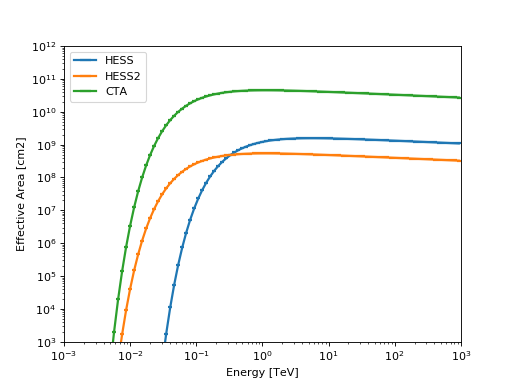EffectiveAreaTable¶
-
class
gammapy.irf.EffectiveAreaTable(energy_lo, energy_hi, data, meta=None)[source]¶ Bases:
objectEffective area table.
TODO: Document
Parameters: energy_lo :
QuantityLower bin edges of energy axis
energy_hi :
QuantityUpper bin edges of energy axis
data :
QuantityEffective area
Examples
Plot parametrized effective area for HESS, HESS2 and CTA.
import numpy as np import matplotlib.pyplot as plt import astropy.units as u from gammapy.irf import EffectiveAreaTable energy = np.logspace(-3, 3, 100) * u.TeV for instrument in ['HESS', 'HESS2', 'CTA']: aeff = EffectiveAreaTable.from_parametrization(energy, instrument) ax = aeff.plot(label=instrument) ax.set_yscale('log') ax.set_xlim([1e-3, 1e3]) ax.set_ylim([1e3, 1e12]) plt.legend(loc='best') plt.show()

Find energy where the effective area is at 10% of its maximum value
>>> import numpy as np >>> import astropy.units as u >>> from gammapy.irf import EffectiveAreaTable >>> energy = np.logspace(-1, 2) * u.TeV >>> aeff_max = aeff.max_area >>> print(aeff_max).to('m2') 156909.413371 m2 >>> energy_threshold = aeff.find_energy(0.1 * aeff_max) >>> print(energy_threshold) 0.185368478744 TeV
Attributes Summary
energymax_areaMaximum effective area. Methods Summary
evaluate_fill_nan(**kwargs)Modified evaluate function. find_energy(aeff[, reverse])Find energy for given effective area. from_hdulist(hdulist[, hdu])Create from HDUList.from_parametrization(energy[, instrument])Get parametrized effective area. from_table(table)Create from Tablein ARF format.plot([ax, energy, show_energy])Plot effective area. read(filename[, hdu])Read from file. to_hdulist()Convert to HDUList.to_sherpa(name)Convert to DataARFto_table()Convert to Tablein ARF format.write(filename, **kwargs)Write to file. Attributes Documentation
-
energy¶
-
max_area¶ Maximum effective area.
Methods Documentation
-
evaluate_fill_nan(**kwargs)[source]¶ Modified evaluate function.
Calls
gammapy.utils.nddata.NDDataArray.evaluate()and replaces possible nan values. Below the finite range the effective area is set to zero and above to value of the last valid note. This is needed since other codes, e.g. sherpa, don’t like nan values in FITS files. Make sure that the replacement happens outside of the energy range, where theEffectiveAreaTableis used.
-
find_energy(aeff, reverse=False)[source]¶ Find energy for given effective area.
A linear interpolation is performed between the two nodes closest to the desired effective area value. By default, the first match is returned (use
reverseto search starting from the end of the array)TODO: Move to
NDDataArrayParameters: aeff :
QuantityEffective area value
reverse : bool
Reverse the direction, i.e. search starting from the end of the array
Returns: energy :
QuantityEnergy corresponding to aeff
-
classmethod
from_parametrization(energy, instrument='HESS')[source]¶ Get parametrized effective area.
Parametrizations of the effective areas of different Cherenkov telescopes taken from Appendix B of Abramowski et al. (2010), see http://adsabs.harvard.edu/abs/2010MNRAS.402.1342A .
\[A_{eff}(E) = g_1 \left(\frac{E}{\mathrm{MeV}}\right)^{-g_2}\exp{\left(-\frac{g_3}{E}\right)}\]Parameters: energy :
QuantityEnergy binning, analytic function is evaluated at log centers
instrument : {‘HESS’, ‘HESS2’, ‘CTA’}
Instrument name
-
classmethod
from_table(table)[source]¶ Create from
Tablein ARF format.Data format specification: ARF file
-